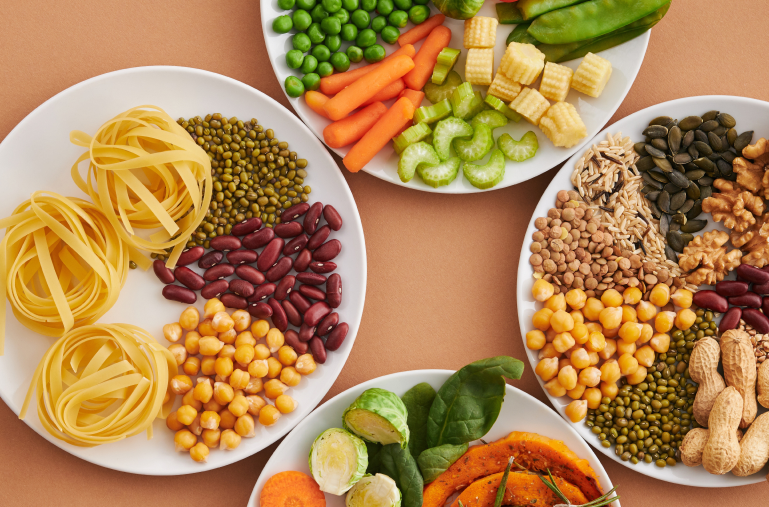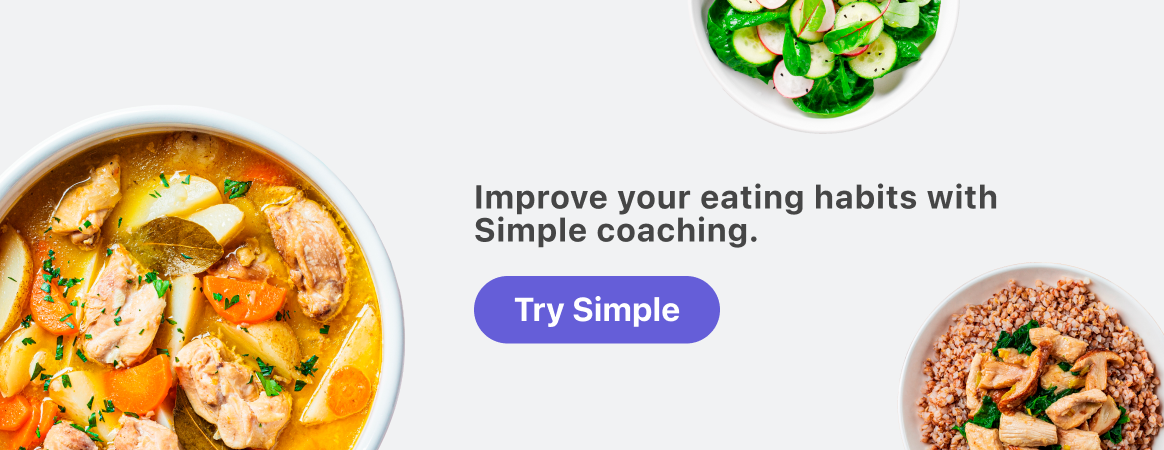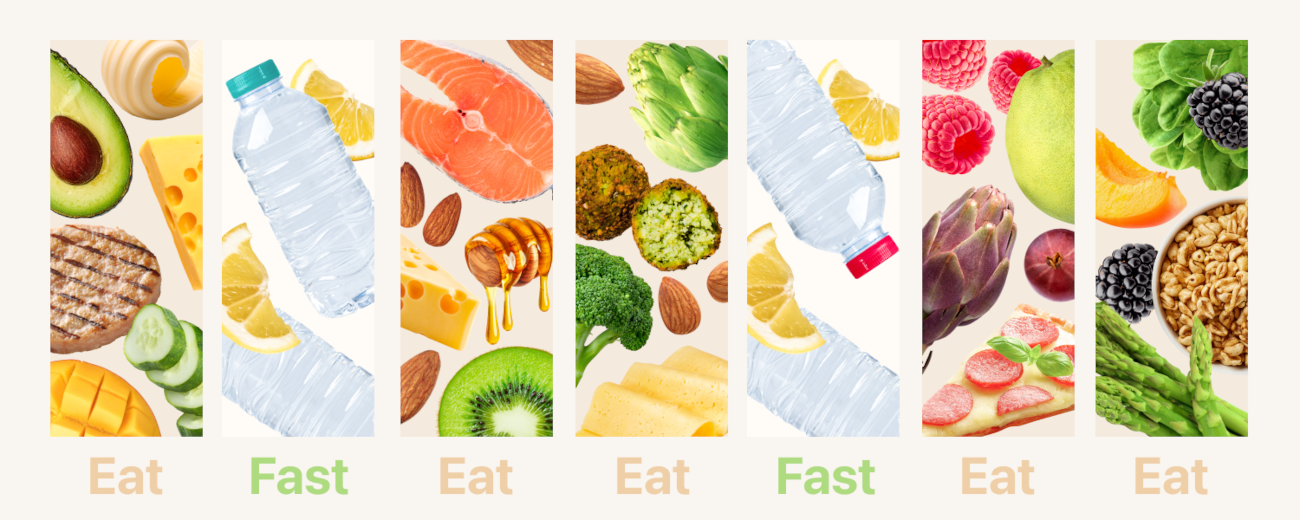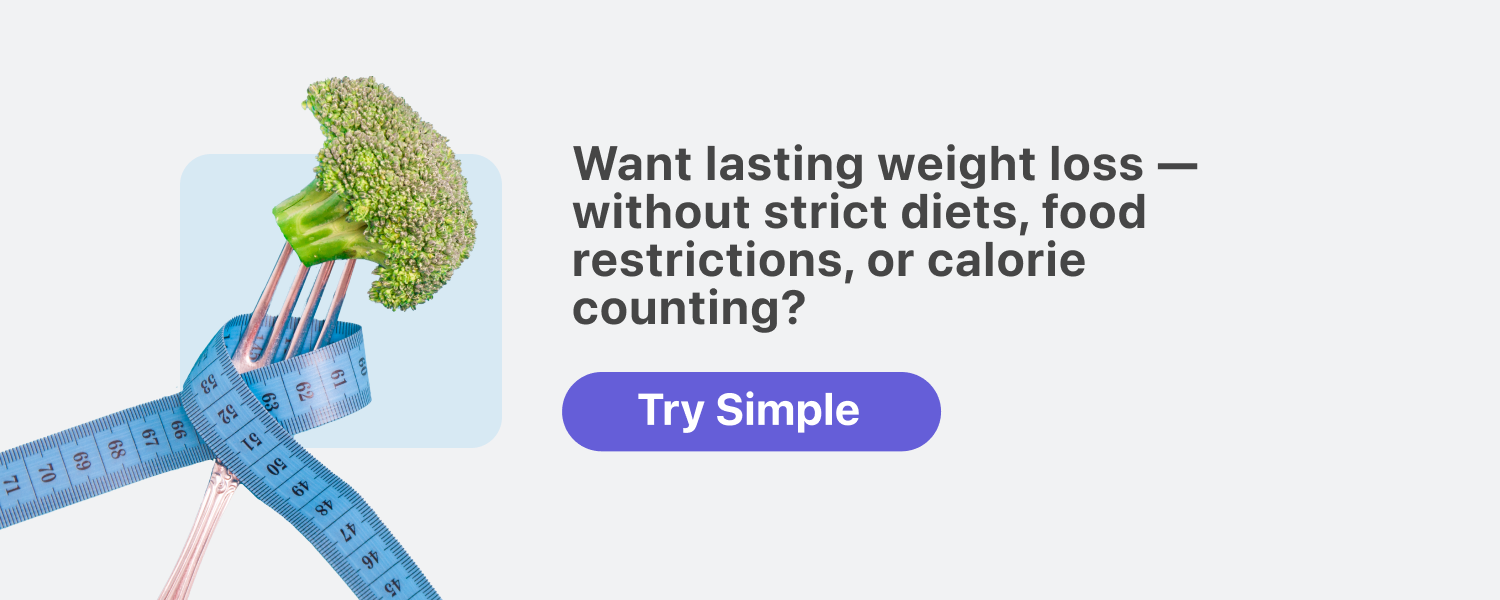Simple’s guide to 5:2 intermittent fasting

“Eat 500 calories two days; eat normally the rest of the week.”
You’ve heard this before.
One of your friends tried it once.
You saw some fitness influencers talking about it.
But you’re not entirely sure how it works or if it’d suit you or your goals.
No worries. You’re in the right place. We’ll help you make an informed choice on whether 5:2 intermittent fasting is right for you or whether you should give it a hard pass. (Spoiler alert: we don’t generally recommend it, but more on that later.)

5:2 intermittent fasting is easy to wrap your head around.
- Five days a week, you eat as you typically would.
- The other two days, you fast.
5:2 fasting days aren’t 100% food-free — you’ll eat roughly 25% of your usual daily caloric intake, around 500/600 calories.
As intermittent fasting approaches go, 5:2 is pretty popular, and intermittent fasting has been around for a long, long time. Some of the world’s greatest philosophers were into it, with Hippocrates, Plato, Socrates, and Aristotle all hyping up the benefits of fasting for both their thinky brains and their bodies. We’re willing to bet that these ancient Greeks also had glowing blood lipid panels and cholesterol levels. Intermittent fasting can do that for you.
Let’s dig into the details.

What is 5:2 intermittent fasting?

As far as “rules” go, a 5:2 fasting schedule involves only those two simple ones from earlier.
During a 7-day week:
- For five days, eat as you like.
- For two days, only 500/600 calories shall pass your lips.
You see, the 5:2 diet isn’t a “diet” at all. It’s an eating pattern.
This may seem like a semantic distinction, but it’s a helpful one (or at least it can be).
Diets are often about restricting food groups and white-knuckling your way through day after day of eating like an undernourished sparrow.
5:2 fasting isn’t like that. Quite the opposite: with 5:2 — or any intermittent fasting schedule, in fact — you can eat whatever you want.
Sure, to get the most bang for your buck, you need to be mindful of your nutrition, but all the foods you love — and a bunch of new soon-to-be favorites, hopefully — are still on the menu.
The biggest challenge of 5:2 fasting surrounds your two fast days — 500/600 calories isn’t much at all. It takes discipline and careful meal planning to practice safely, and we don’t recommend it on a regular basis (and definitely not without checking in with your doctor first).
That’s why the approach we recommend the most is time-restricted eating. With this method, you fast for several hours, most likely overnight, then enjoy an “eating window” of normal eating.
However, the most important thing to remember when it comes to any fasting schedule is that it should suit you: your lifestyle, your body, your goals, and your needs. Fasting also isn’t right or safe for everyone, so you should always involve your healthcare provider in brainstorming what approach(es) might work for you.
We can also help with that! Take our Simple quiz to tell us about you and your goals, and we can make personalized fasting recommendations that support you and your health and well-being.
Building a healthy 5:2 plan
Even though we don’t recommend it, if you are going to follow a 5:2 fasting schedule, there’s one simple tip that’s essential for supporting your body, mind, and spirit:
Leave at least one day between fast days.
To make this lifestyle sustainable — and so that you don’t hate life due to intense hunger — fasting days need to be non-consecutive.
That makes sense, right? If you had the choice (and you do), you’d never go two days back-to-back eating only 500/600 calories. People wouldn’t be safe — two days in a row of modified fasting is enough to turn even the sweetest human into someone who descends into an uncontrollable rage (or at least heavy tutting) at their partner for breathing too loudly.
Of course, remaining a reasonable, upstanding member of society isn’t the only reason. There’s no getting around it: Your body needs regular food. Eating enough matters because undernourishment is a real thing that hurts your health.
So, structure your fasting with care and smarts — and only with prior approval from your primary care provider.
Like this, for instance:

How to eat on fast days when doing 5:2 intermittent fasting

Like with any intermittent fasting schedule, when practicing 5:2, you are the boss of your food choices.
As you construct your fasting menu, consider how different foods impact how you feel and function. Your choices will also make a big difference in how easy or hard you find it to get through a fasting day.
One of the best ways to ensure feel-good, high-functioning vibes and a smooth fasting experience:
Eat nutrient-dense foods, like colorful veggies, fruits, whole grains, lean proteins, and healthy fats. Foods like these will help you feel full longer, reduce hunger, and stave off cravings.
Soups and broths can be good options to help you feel satisfied and energized, as they’re super hydrating. Choose (or make) ones full of veggies and protein, like:
- vegetable and barley soup with chicken
- pumpkin and turkey chili
- beef and root vegetable stews
By contrast, processed foods high in refined carbohydrates, sugar, salt, and unhealthy fats, like crackers, chips, pasta, white rice, or sweets, are more likely to intensify your hunger and spark strong cravings.
The bottom line:
Make every one of your 500/600 calories work for its place in your fasting day menu. No freeloaders allowed!
If this is all new to you, you might not be sure yet how filling the food you eat is. That’s OK. Explore different options and notice how you feel.
And if you need more support, we’re here to help. Try logging your food in our free Simple app for helpful feedback on your meals, plus ideas on how to improve them. You can also explore our guide on how to build a meal plan, which can be adapted to any fasting schedule and dietary requirements.
A final tip here:
When you’re fasting, stay hydrated.
Fasting days can leave you feeling tired and headachey, so drink lots (our definitive guide on what you can drink while fasting will show you the best calorie-free options).
How to eat on regular days when doing 5:2 intermittent fasting
The same idea holds up on a non-fast day, too.
Make your foods work hard and shoot for nutritious choices, like fruit, fresh veggies, whole grains, and lean protein.
To keep your appetite in check, your energy up, and your cravings under control, pack your daily menu full of foods that are:
- high in fiber
- rich in nutrients
- high in protein
- low in calories, high in volume
It’s also critical for getting as much benefit as possible from following your intermittent fasting 5:2 plan.
Think about your goals for intermittent fasting. What do you want to achieve?
Build your food choices around that.
So, if you’re 5:2ing for weight loss or to improve your health, these foods are your friends. Eat them often.
Dealing with hunger and other possible negative side effects
We’ll be real with you: 5:2 can make you more hungry than other intermittent fasting schedules. It’s one of the reasons we don’t recommend it.
To fend off that hungry stage, make sure you:
- drink lots of water
- eat high-volume, low-calorie foods, like veggies and fruits, so you can eat plenty (while staying within your calorie limit on fast days)
- learn how to distract your mind so it doesn’t get stuck thinking about food
There are many ways to hack hunger while fasting, and the three above will help a lot.
5:2 fasting can also cause:
- low energy
- feeling cold
- lack of concentration
- headaches
- dizziness
While these side effects will likely improve as your body adjusts, listen to your body and take a break if and when you need to. When your energy is low, rest up. Make sure you’re drinking enough water (which helps ease things like headaches and lightheadedness). And if any side effects become persistent or severe, stop fasting immediately and speak to your doctor before jumping back in.

5:2 fasting for weight loss
For weight loss, 5:2 intermittent fasting is a proven method that gets results. In fact, research suggests that many people find it easier than traditional calorie-counting diets [1] because with 5:2 you only count calories two days out of seven.
(Simple top tip: planning your meals and snacks ahead of time can make it even easier.)
Studies also show that 5:2 fasting and traditional calorie-counting diets achieve the same amount of weight loss.[2]
However, while some studies suggest 5:2 fasting may be more effective than time-restricted eating for weight loss specifically,[3] we would still recommend trying other fasting approaches first since these are easier to manage.
Regardless of what fasting schedule you follow, if weight loss is the outcome you want, be mindful of the foods you consume and use your fasting window to create a calorie deficit (simply, eating less calories than you burn).
If exercise is your jam — or you want it to be — great! Intermittent fasting is evenmore effective when combined with exercise, so do both and see what you can accomplish.[4]
Health risks and benefits of 5:2 intermittent fasting
Aside from weight loss, what goodness could 5:2 fasting — or any intermittent fasting schedule, for that matter! — bring to your life and your body?
Quite a lot, as it happens!
Lower risk of type 2 diabetes
A growing body of evidence suggests that intermittent fasting can help lower the risk of type 2 diabetes [5] by reducing body weight and improving fasting glucose,[6] fasting insulin levels, and insulin resistance.[7]
Improved insulin sensitivity
On a similar theme, studies have shown that intermittent fasting also improves insulin sensitivity.[8]
Lower risk of cardiovascular disease
One study suggests that intermittent fasting shows promising effects on the cardiovascular system, including lowering heart health risk factors like blood pressure and inflammation.[9] Cholesterol levels also seem to benefit,[10] and a 2021 review found that intermittent fasting was more effective than calorie restriction at reducing the risk of heart disease.[11]
Better brain health
Brains also enjoy a little fasting action, with studies demonstrating positive benefits on overall brain function and a reduced risk of cognitive disease.[12,13]
The evidence is growing and encouraging. All that said, further research — particularly longer-term studies — is still needed.
The risks
5:2 isn’t 100% risk-free, and it does tend to bring up more potential risks than less restrictive fasting schedules.
You may feel tired, weak, headachy, irritable, or struggle to concentrate. Perhaps you’re more moody than usual or have trouble falling asleep.
And, of course, there’s hunger. If it gets too strong, you can end up eating more than you need or want, and that can have a physical, mental, and emotional impact.
The good news is that all these effects tend to be short term, and you have the power to mitigate them via the actions you take.
Just remember: you’re calling the shots here, and if something doesn’t feel right, it may be time to stop and reassess your approach.
Is 5:2 intermittent fasting safe?
Again, we don’t typically recommend 5:2 intermittent fasting — its level of restriction means it can introduce more potential risks and safety concerns compared to a less restrictive fasting approach.
While everyone who’s considering any type of intermittent fasting should have conversations with their healthcare team, due to the effects fasting can have on blood sugar levels, your relationship with food, and body weight management, you should avoid fasting or be particularly cautious if you:
- have type 1 diabetes;
- are pregnant, breastfeeding, or trying to conceive;
- are prescribed medication (like hypertensives or any medications that need to be taken with food);
- are extremely active;
- have a history of or are currently diagnosed with disordered eating;
- have a BMI of less than 18.5; or
- are under 18 or 80 years or older.
Before we move on, let’s talk about intermittent fasting for men and women. For some women, intermittent fasting and hormones may not play nicely together, so be aware of the risks if estrogen and progesterone are in your hormonal mix.
Pros and cons of intermittent fasting 5:2
| Pros | Cons |
| You choose what to eat | Hunger and other side effects |
| Set your own fasting schedule | Not suitable for everyone |
| It’s good for your health | Takes some getting used to |
| A lifestyle, not a diet | Not super intuitive |
Pros explained
On the 5:2 schedule, you choose your fasting days, and no foods are off-limits. This means you’re in the driver’s seat of making 5:2 fasting fit your life.
If you’re a social animal who loves eating with friends on the weekend, you can rock and roll, baby. Or, if you have a busy schedule on Monday and Thursday and just want one less thing to think about, you can hit your fast days then.
Use your 5:2 routine to supercharge your health while living a full life as a well-rounded human.
Cons explained
5:2 fasting takes a bit of getting used to, and, honestly, it’s not right for everybody. It’s also — we can’t stress this enough — more potential stress and hassle than other less restrictive fasting approaches.
You’re going to feel hungry and grumpy while your body adjusts. You might find it tricky to go against your appetite cues, but with practice, you’ll settle in (and avoid the rookie intermittent fasting mistakes that can disrupt your efforts).
Is the intermittent fasting 5:2 method right for you?

Only you can answer that. Well, you, with the help of your healthcare team …
5:2 fasting might be up your alley if …
- the idea of fasting only two days out of seven appeals to you
- you feel able to hit 500/600 calories on each of those two days
- it supports your health goals
- you’re an experienced faster and meal-planner
If that’s you, give it a shot!
If you like the idea of intermittent fasting but 5:2 leaves you cold …
… maybe a different option could work for you.
(Not sure which one to choose? Take our Simple quiz, and we can help you figure out the best schedule for your unique body, preferences, and lifestyle.)
5:2 fasting vs. intermittent fasting 16:8 (or other time-restricted eating patterns)
With intermittent fasting 16:8, you’ll fast for 16 hours and consume all your calories in the remaining eight hours. You choose your fasting periods — they’re shorter, which makes hunger less of an issue — and you don’t need to count calories.
This could be an excellent “Intro to intermittent fasting” option, as could other time-restricted fasting approaches, like 12:12 or 14:10. They’re our most recommended fasting schedules for a reason! On the other hand, 16:8 fasting is typically an everyday deal, and that may not jive as well with your lifestyle.
5:2 fasting vs. alternate-day fasting (ADF) or 4:3
With alternate-day fasting (also known as 4:3 fasting), you fast every other day and eat as you typically would on the days between. Like 5:2, not fasting every day might fit your life better. However, there are more fasting days per week, and hunger (not to mention other potential side effects) can be a real challenge. For those reasons, this fasting approach falls under our “not recommended” stance.
5:2 fasting vs. one meal a day (OMAD)
OMAD requires you to fast for 23 hours and eat all your nutrients in a one-hour window. You can schedule your eating window any time that works for you, but it’s pretty restrictive, and we don’t recommend fasts of this length.
5:2 fasting vs. water fasting
Water fasting — where you only consume water for 24 to 72 hours — is a short-term option. It’s an extreme schedule, and we don’t recommend you try it.
Yes, so long as you make sure to eat a nutrient-rich diet on your non-fast days. That said, “healthy” is a relative term, and what works for one person may not suit another, so listen to your body and be guided by how you feel.
It’s best to avoid the 5:2 diet or intermittent fasting overall if you:
- have type 1 diabetes;
- are pregnant, breastfeeding, or trying to conceive;
- are prescribed medication (like hypertensives or any medications that need to be taken with food);
- are extremely active;
- have a history of or are currently diagnosed with disordered eating;
- are extremely active
- have a BMI of less than 18.5; or
- are under 18 or 80 years or older.
This review found intermittent fasting led to a typical weight loss of 7–11 lbs (3–5 kg) over 10 weeks.[14] While it likely won’t be this linear, you can lose between 0.5–1 lb (0.2–0.5 kg) a week on 5:2 (a safe, sustainable rate).
Not only does the 5:2 diet not have to be consecutive days, but we’d highly recommend it isn’t! Trust us on this one; it’ll make for a much more pleasant experience if you put one to three non-fast days between your fasts.
Can you exercise on fasting days on the 5:2 diet? Absolutely! Listen to your body, pay attention to your energy levels, and notice how you feel. Get used to your 5:2 routine before you add fasted exercise in, and go easy on the intensity at first.
Your goals will determine how long you fast for on 5:2. Once you’ve reached your goals, you can always switch out to a higher calorie intake on fast days, or to a different intermittent fasting schedule like 12:12 or 14:10, in order to maintain the benefits you’ve seen.
How long it’ll take to see results on the 5:2 diet depends on you.
Your results will be influenced by many factors, like stress,[15] sleep,[16] what you eat, how you move, your age, lifestyle, and so on, but your actions are key. Stick with your plan, make wise food choices, and you’ll see swifter results.
The science suggests so! Although more research would be welcome, there’s strong evidence that the 5:2 diet works. Whether it’ll work for you … try it and find out! Get started here.

- Varady KA, Bhutani S, Church EC, Klempel MC. Short-term modified alternate-day fasting: a novel dietary strategy for weight loss and cardioprotection in obese adults. Am J Clin Nutr. 2009 Nov;90(5):1138–43.
- Rynders CA, Thomas EA, Zaman A, Pan Z, Catenacci VA, Melanson EL. Effectiveness of Intermittent Fasting and Time-Restricted Feeding Compared to Continuous Energy Restriction for Weight Loss. Nutrients [Internet]. 2019 Oct 14;11(10).
- Varady KA, Cienfuegos S, Ezpeleta M, Gabel K. Cardiometabolic Benefits of Intermittent Fasting. Annu Rev Nutr. 2021 Oct 11;41:333–61.
- Bhutani S, Klempel MC, Kroeger CM, Trepanowski JF, Varady KA. Alternate day fasting and endurance exercise combine to reduce body weight and favorably alter plasma lipids in obese humans. Obesity. 2013 Jul;21(7):1370–9.
- Barnosky AR, Hoddy KK, Unterman TG, Varady KA. Intermittent fasting vs daily calorie restriction for type 2 diabetes prevention: a review of human findings. Transl Res. 2014 Oct;164(4):302–11.
- Arnason TG, Bowen MW, Mansell KD. Effects of intermittent fasting on health markers in those with type 2 diabetes: A pilot study. World J Diabetes. 2017 Apr 15;8(4):154–64.
- Harvie MN, Pegington M, Mattson MP, Frystyk J, Dillon B, Evans G, et al. The effects of intermittent or continuous energy restriction on weight loss and metabolic disease risk markers: a randomized trial in young overweight women. Int J Obes . 2011 May;35(5):714–27.
- Cho Y, Hong N, Kim KW, Cho SJ, Lee M, Lee YH, et al. The Effectiveness of Intermittent Fasting to Reduce Body Mass Index and Glucose Metabolism: A Systematic Review and Meta-Analysis. J Clin Med Res [Internet]. 2019 Oct 9;8(10).
- Malinowski B, Zalewska K, Węsierska A, Sokołowska MM, Socha M, Liczner G, et al. Intermittent Fasting in Cardiovascular Disorders-An Overview. Nutrients [Internet]. 2019 Mar 20;11(3).
- Tinsley GM, La Bounty PM. Effects of intermittent fasting on body composition and clinical health markers in humans. Nutr Rev. 2015 Oct;73(10):661–74.
- Allaf M, Elghazaly H, Mohamed OG, Fareen MFK, Zaman S, Salmasi AM, et al. Intermittent fasting for the prevention of cardiovascular disease. Cochrane Database Syst Rev. 2021 Jan 29;1(1):CD013496.
- Ooi TC, Meramat A, Rajab NF, Shahar S, Ismail IS, Azam AA, et al. Intermittent Fasting Enhanced the Cognitive Function in Older Adults with Mild Cognitive Impairment by Inducing Biochemical and Metabolic changes: A 3-Year Progressive Study. Nutrients [Internet]. 2020 Aug 30;12(9).
- Currenti W, Godos J, Castellano S, Caruso G, Ferri R, Caraci F, et al. Association between Time Restricted Feeding and Cognitive Status in Older Italian Adults. Nutrients [Internet]. 2021 Jan 9;13(1).
- Seimon RV, Roekenes JA, Zibellini J, Zhu B, Gibson AA, Hills AP, et al. Do intermittent diets provide physiological benefits over continuous diets for weight loss? A systematic review of clinical trials. Mol Cell Endocrinol. 2015 Dec 15;418 Pt 2:153–72.
- Rabasa C, Dickson SL. Impact of stress on metabolism and energy balance. Current Opinion in Behavioral Sciences. 2016 Jun 1;9:71–7.
- McHill AW, Wright KP Jr. Role of sleep and circadian disruption on energy expenditure and in metabolic predisposition to human obesity and metabolic disease. Obes Rev. 2017 Feb;18 Suppl 1:15–24.
